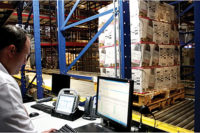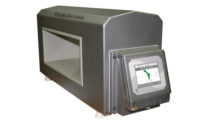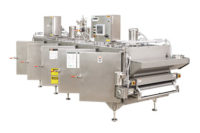Cold storage is a crucial component of food quality and safety. Today’s cold-storage systems boast numerous improvements in automation, design and customization that also help improve energy efficiency and flexibility while reducing operating costs.
Flexible and efficient
“Flexibility is being incorporated into cold storage designs,” says Gerry Gomolka, vice president, business development, Stellar, Jacksonville, FL. “One example is the ability to convert a cooler into a freezer. These kinds of adjustments, built into the initial design stage, make it easy for facilities to accommodate cooler- or freezer-based products in the future.”
Because cold-storage energy costs can reach hundreds of thousands of dollars per month, efficiency is a top priority. “At Stellar, we employ a waste-to-energy service for cold-storage facilities,” says Gomolka. “We recover waste heat from manufacturing equipment and reheat the water to use for both steam generation and cleaning. We also can recover wastewater, HVAC compensate, tower water and rainwater to use for irrigation systems.”
Stellar also offers cool roofs—thermoplastic polyolefin, single-ply roofing systems. The systems’ white membrane reflects the sun’s heat, maximizing a facility’s utility efficiency and reducing energy costs. A white, TPO, single-ply roofing system also can help plants maintain a cooler interior environment.
Ready to freeze
Automation lets refrigeration control systems generate trend analyses, alarm logs, energy management data and runtime reports, which allow plant managers to make sure their systems are running at optimal efficiency.
GEA Refrigeration Technologies GmbH, Bochum, Germany, recently introduced S-Tec spiral freezers, which chill and freeze products with the help of advanced automation. Energy efficiency is delivered within the spiral system and refrigeration plant room via analysis of the air velocity and temperature used to freeze or chill products. In addition, a sequential defrost capability allows frost accumulation to be removed in a freezer during production.
Master-Bilt Products, New Albany, MS, manufactures walk-in coolers, freezers and warehouses that keep bakery products fresh while preventing bacterial formation. “The walk-in panels are polyurethane foamed-in-place for dependable insulation,” says Lynn Burge, marketing manager. “As a barricade between perishable items inside and warmer temperatures outside, the entry doors withstand the numerous openings and closings of a typical business day without losing structural integrity.”
From a minimum 6-by-6-foot size to more-elaborate 10,000-square-foot warehouses, Master-Bilt walk-in refrigeration systems can be customized to provide the right amount of temperature-controlled space, adds Burge. Basic modular panel sizes and heights fulfill various design requirements.
Praxair Inc., Danbury, CT, manufactures in-line cryogenic freezers that quickly chill products to retain their appearance, quality and shape for packaging. “Slow freezing can diminish quality and taste in a bakery product,” says Frank J. Martin, marketing manager, food refrigeration. “Praxair’s cryogenic freezing quickly locks in flavor to minimize any loss of the freshly baked taste. All of our freezing systems are designed for continuous production, resulting in labor savings and consistent, high-quality products.
“In-line chilling of finished bakery products is another important application in a bakery process,” Martin continues. “A small cryogenic system can quickly set up coatings or frosting on finished goods to preserve the appearance through the packaging process.”
Praxair recently upgraded its Ultra Performance spiral freezer to improve capacity and sanitation, and enhanced its horizontal vapor flow to provide additional cooling capacity. These features, combined with wider belts than freezers of similar size, ensure efficient use of cryogen while providing maximum production capacity in a minimal footprint, according to the company.
The Rytec Turbo-Slide insulated door from Rytec Corp., Jackson, WI, provides a secure barrier between frozen, cold and ambient environments. “It combines the insulating qualities of rigid doors with a Flex-Panel system that is lightweight and durable,” says Michael Watkins, vice president of marketing. “Closed-cell foam provides an insulating barrier that is resistant to moisture, mold and mildew. Also, the core is encased in a thermoplastic outer shell that is crack-resistant and USDA- and FDA-approved for food contact.”
Thermal options available on the Rytec door range from a standard R-17 to R-40 for extreme conditions. In addition, opening speeds of up to 125 inches per second ensure quick traffic movement. “The door is suitable for high-volume operations where high-cycle durability and energy savings are critical,” Watkins adds.
Customized coolers
The best way to improve product quality and productivity is to design and construct a freezer customized to a specific product, says Brian T. King, president, A M King, Charlotte, NC. Such a system must take into account product type, temperature entering the freezer, amount of time required to fully freeze the product and the packaging used. A customized freezer design also should accommodate the amount of automation a bakery or snack plant requires for its freezer operation.
“We have designed and constructed freezers that are fully automated, where a person never enters the room, to freezers that are large, open spaces where the product is manually moved in for a period of time to freeze, and then manually transported to a larger holding area for future distribution,” King explains. “Obviously, the higher the degree of automation, the greater the initial cost, but more automation will result in significant labor savings over time.”
King cites an example of a customized cold storage system his company developed with a customer: “We designed a freezer for a high-volume bakery. To manually move the product from the packaging line into a freezer would have required a great amount of labor and equipment. So we worked with the client and equipment vendors to develop an automated system wherein the product is automatically transferred from packaging directly into a custom-built freezer. Product is then stored on a 60-foot-high racking system. This not only eliminates the need for manual labor during the freezing and storage process, it also allows for the freezer facility to expand vertically rather than horizontally, thereby requiring less area while providing greater storage volume.”
GEA Refrigeration Technologies recently worked with a European bakery to improve its cold-storage operations. “The plant was unable to meet full production demand due to the constant need to defrost the freezing evaporators caused by frost accumulation after two or three shifts,” explains David Hallifx, sales director, freezing technology. “The defrosting sequence required the spiral system to shut down for hours, interrupting production flow. GEA retrofitted a new sequential defrost system with evaporators, refrigeration valve stations and controls that allows production to continue at full capacity for 20 shifts.”
Future directions
Food safety continues to be the primary driver of cold-storage system improvements. “To meet sanitary-design standards, refrigeration equipment should be designed without nooks, cracks and crevices to eliminate areas where microorganisms may cultivate,” says Gomolka. “Equipment also should be designed with sanitary equipment finishes, such as high-grade stainless steel. All are important areas to address to ensure food safety within bakeries and snack food plants.”
Hallifax says GEA is seeing more demand for its recirculating clean-in-place (CIP) systems, which repeatedly sanitize heavily soiled equipment. “Recirculation allows repeated cleaning without an undue penalty of water or chemical consumption,” he explains.
King sees a major effort to minimize the amount of refrigerant used in large cold-storage systems. “There also is a significant incentive to decrease the amount of energy required to operate a freezer,” he says. “This is being achieved through the development of more energy-efficient equipment. We will continue to see improvements in the reduction of both refrigerants and energy in cold-storage systems.”











